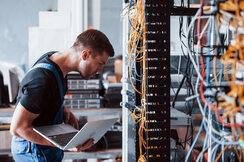CCNA - Cisco Certified Network Associate Training Course
This course is designed for anyone seeking CCNA certification. The course also provides foundational knowledge for all support technicians involved in the basic installation, operation, and verificati...
- All levels
- English

Course Description
This course is designed for anyone seeking CCNA certification. The course also provides foundational knowledge for all support technicians involved in the basic installation, operation, and verification of Cisco networks.Cisco Certified Network Associate (CCNA) is a widely-recognized IT certification for professionals who are beginning their IT careers. The CCNA certification course is ideal for p...
This course is designed for anyone seeking CCNA certification. The course also provides foundational knowledge for all support technicians involved in the basic installation, operation, and verification of Cisco networks.Cisco Certified Network Associate (CCNA) is a widely-recognized IT certification for professionals who are beginning their IT careers. The CCNA certification course is ideal for professionals who are part of digital transformation initiatives that help in business growth and new-age infrastructure. Cisco Certified Network Associate (CCNA) certification course validates your knowledge and skills in the fundamentals of networking, IP connectivity, security, automation, and more. The Cisco Certified Network Associate v1.0 (CCNA 200-301) exam is a 120-minute exam associated with the CCNA certification.The course, Implementing and Administering Cisco Solutions (CCNA), helps candidates prepare for this exam.
See more See lessWhat you’ll learn
- Live Class Practical Oriented Training
- Timely Doubt Resolution
- Dedicated Student Success Mentor
- Certification & Job Assistance
- Free Access to Workshop & Webinar
- No Cost EMI Option
- Network fundamentals in the form of network components, topology, virtualization, switching concepts, & more Install, op...
- Host-to-host communication through routers and switches. Resolve network issues and common problems with IPv4 addressing
- Describe IPv6 main features and addresses, and configure and verify basic IPv6 connectivity.
- Describe concepts of wireless networks, which types of wireless networks can be built & how to use Wireless LAN Controll...
- Installing switches to perform the initial configuration Understanding routing and implementation of a Cisco router
- VLANs, trunks, and inter-VLAN Routing. Spanning Tree Protocol (STP) and Rapid Spanning Tree Protocol (RSTP)
- Configure Internet access using Dynamic Host Configuration Protocol (DHCP) clients and explain and configure Network Add...
- Describe the operation, benefits, and limitations of static routing
Curriculum
Frequently Asked Questions
This course includes
- Duration 130 Hour
- Language Hinglish
- Certificate Yes
Education Provider
More Courses

3D Printing Training Cour.
- ₹ 5000

3ds Max Training Course
- ₹ 20000

AI & Deep Learning with T.
- ₹ 40001

ASP.NET Core Live Project.
- ₹ 24999

ASP.NET Live Project Trai.
- ₹ 45000
